Contaminant screening is a basin-wide shore sampling programme devised by ROPME and carried out in collaboration with MEL/IAEA as a complementary project to the Oceanographic Cruises, so that the water, sediment and biota of the coastal areas are periodically sampled to ascertain the status of contaminants. Thus far, screening has been carried out five times, during 1994, 1997, 1998, 2000/2001 and 2005, resulting in an invaluable data base of contaminants and reports at ROPME.
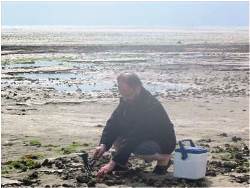
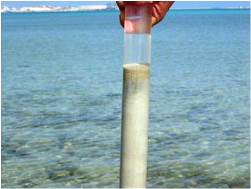
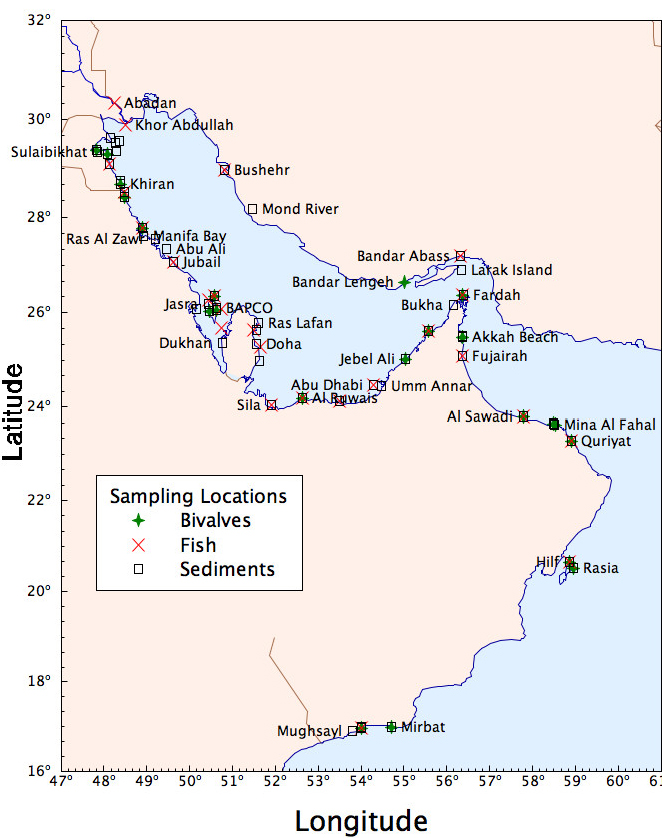
Specifically, surveys of heavy metal and organic contaminants in sediments and biota have taken place in Bahrain, Kuwait and UAE (June 1994), in I.R. Iran, Oman and Qatar (1997), in Kuwait and Saudi Arabia (October 1998, in Qatar and UAE (March 2000), in Bahrain (November 2000) and in Oman (August 2001), in addition to the comprehensive survey undertaken between February-March 2005 for the same target analytes in the key coastal sites of all ROPME- Member States. In addition, estimation of Methyl Mercury in sediments and biota carried out during1994 (Bh-Ku-UAE) and 1998 (Ku- SA); Organotin in sediments and biota during 2000-2001 (Bh- Qa- UAE- Oman) and Faecal Sterols in sediment during 1994 (Bh-Ku-UAE) and 1998 (Ku-SA).
1. Trace Metals
- The majority of trace metals concentrations in sediments and biota correspond to natural background levels in marine environments
- Mercury concentrations continue to be very low in sediment and the observed total Hg levels in fish (Hamoor) maintained to be below the 0.5 µg g-1 (wet wt) threshold
- Unexplained high concentrations of Arsenic have been maintained in some bivalves during 1994-2005
- Nickel and Chrome dominant in high concentration in almost all collected inter-tidal sediments
Examples of Obtained Results:
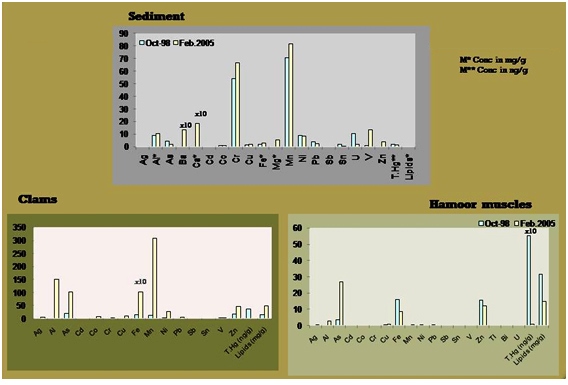
Trend of Country-Mean of Metal Concentration (µg g-1) in the Kingdom of Saudi Arabia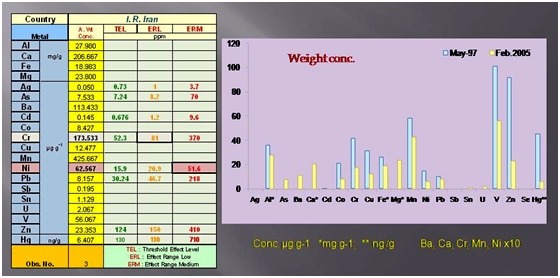
Levels of Metals Concentration in Near-shore Sediment in I. R. Iran2. Petroleum Hydrocarbons
- With few exceptions in RSA, the general temporal trend of levels of Petroleum Hydrocarbons (PHC) in sediments & biota have been decreased during the period 1994-2005.
- Levels of PCH in Sediments lie actually within the permissible level for the Region (15µg/g, as CEU).
- Chronic PHC pollution in RSA prevails in the vicinity of the BAPCO industrial complex (Bahrain), at Mina al Fahal (Oman) and to lesser extent in the surroundings of Sulaibikhat & Doha Bay (Kuwait).
- PHC concentrations in biota have decreased to values reported before the 1991 War.
- Prevailed PHC levels in fish and bivalves are actually comparable to those concentrations observed in relatively unpolluted areas elsewhere in the world.
- The historical high levels in Oysters from Mina al Fahal (Oman) and around Akkah Head (UAE) are still maintained.
Examples of Obtained Results:
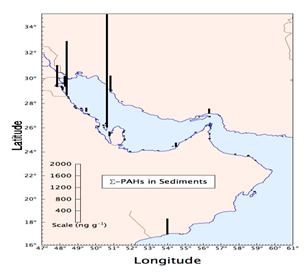
Spatial Distribution of Polyaromatic Hydrocarbons (PAH) in the near shore sediments of RSA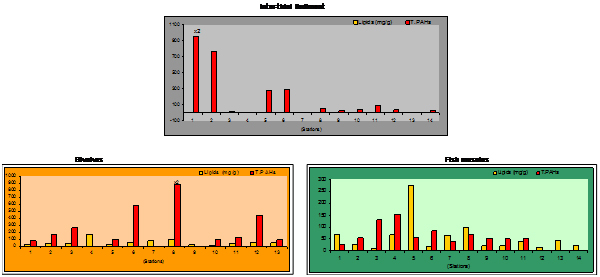
Temporal trend of PAHs in sediments and biota from RSA in ng/g-d.wt. as mean Country in RSA3. Chlorinated Hydrocarbons
Generally, concentrations of DDTs and PCBs in sediments and biota maintain their extremely lower levels than global standers during 1994-2005.
Examples of Obtained Results:
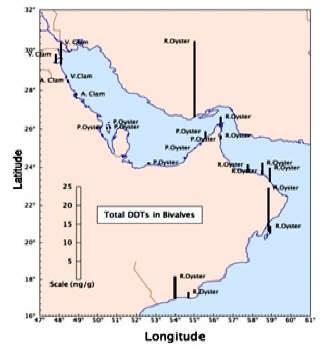
Spatial Distribution of S DDTs in pg/g- d.wt in Bivalves from RSA 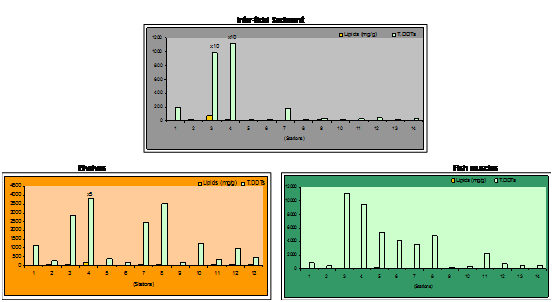
Temporal trend of S DDTs in pg/g-d.wt in sediment and biota, as mean country in RSA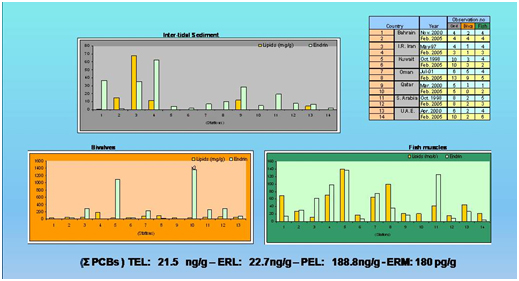
Temporal Trend of T.PCBs (pg/g-d.wt) Country Mean in RSA Marine Environment4. Methyl Mercury
- In both 1994 & 1998 surveys, muscles of big fishes contained high concentrations of total Hg(T. Hg) and Me-Hg similar to these reported in previous surveys in the Region (in mid-1980 and 1993-94)
- Highest measure levels of Hg found in fishes from Kuwait in both surveys (in Bubiyan,1994 and in S. Kuwait,1998)
- Usually, Methyl Mercury (Me-Hg) comprised the bulk of T. Hg in fish muscles from the Region
- Generally, Hg levels in fish muscles not exceeded 0.5 mg/kg -wet wt (permissible consumption limit)
- Bivalves usually characterized by Hg and Me-Hg levels less than found in fishes and higher that those in sediments with much lesser amount of Me-Hg in T. Hg
Examples of Obtained Results:
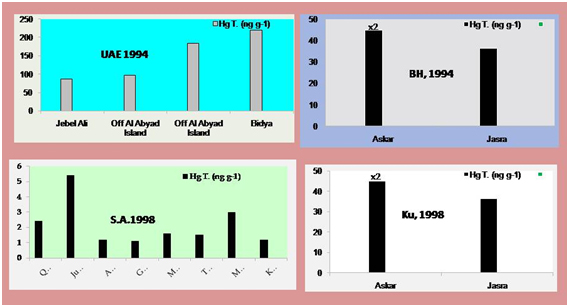
Levels of Methyl Mercury (ng/g-dw) in Near-shore sediments in RSA5. Organotin Compounds
- In Sediments,Tetrabutyl Tin (TBT) found in significant amounts at Jebel Ali port (UAE), Umm Said, Dukhan (Qatar), and off BAPCO (Bh.)
- In Bivalves,TBT, DBT and TPhT presented with much higher levels in Pearl oysters from Abu Dhabi (UAE) and off BAPCO in Bh. In Rock oysters, Total Butyltins and TBT were relatively low except in Akkah Beach and Abu Dhabi in UAE and Hilf in Oman, reflecting detected high levels in their surrounding sediments
- In Fish, TBT was low in most of analyzed fish .Exceptions were detected in muscle of some species from Badaiya (Bh), Umm Said and Doha (Qatar) and Quriyat (Oman). The derivatives Diphenyltin (DPHT) and Triphenyltin (TPHT) are detected in grouper from Al Khawr (Qatar)
Examples of Obtained Results:
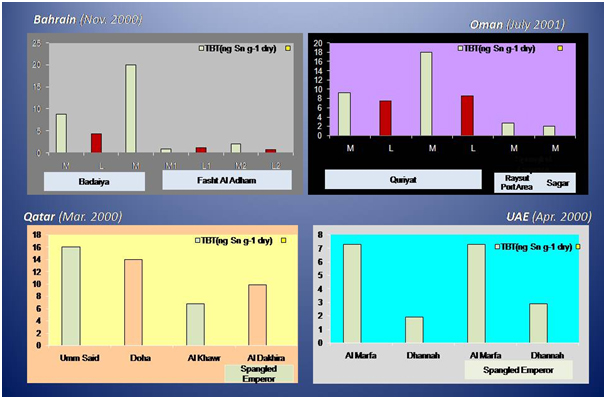
Levels of Tributyltin (TBT) in Fish Muscles and Liver (Orange-spotted Grouper) from RSA during 2000-016. Faecal Sterols
- Survey of 1994 identified sewage contamination, only at Shuwaikh Bay in Kuwait and to lesser extent at Jasra (Bahrain).
- Sediments from Iran, Oman and Qatar (1997) and from SA in 1998 didn’t indicate significant domestic pollution ( Corpostanol < 100 ng/g
- During 2000-01 survey , levels of Sterols, as Corpostanol, kept their low levels in sediments from UAE, Qatar and Oman with relatively higher conc. (around 200 ng/g) in one site in each country
Examples of Obtained Results:

Trend of Sterols Concentration (µg/g) in Sediments in Qatar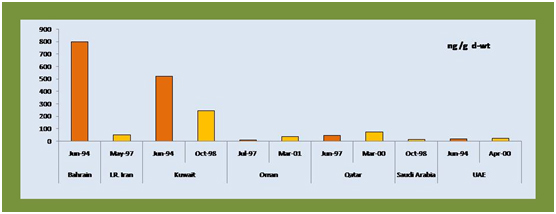
Levels and Trend of Country Mean Conc. of Coprostanol in Sediment of RSAThe obtained results and observations of the Contaminant Screening Activities during the two decades (1994-2005) have been recently discussed in detail and assessed during a Regional Technical Experts Meeting, held in State of Kuwait during October 2009.
The first objectives of the Meeting were to identify the needs and priorities for the future contaminants’ screening activities for the Region and integrate the efforts with the following relevant ongoing and/or planned ROPME Monitoring Programmes:
- Assessment of Organotin Contaminants in the RSA
- Reconstruction of Pollution History in the RSA
- Regional Mussel Watch Programme
- Assessment of Marine Radioactivity in the RSA
Another objective of the Meeting was also to establish a mechanism for harmonization of ongoing National Monitoring Programmes with the National and Regional Contaminants Monitoring Objectives and a liaison with relevant International Programmes. The Technical Meeting recommended to update the ROPME Reference Contaminants List with additional contaminants of recent environmental concern in the Region and to continue the Regional Contaminant Screening Programme with a preferred frequency of 5 years in collaboration with ROPME Member States and MEL/IAEA.
In order to strengthen self dependence for Contaminants Screening in the Region. The Regional Experts in the Meeting found necessary to develop Regional Reference Laboratories that provide standards, guidance, training and a dependable analytical facility to the Member States. Regarding monitoring of contaminants in marine environment in the RSA .In response to this important need, ROPME is planning to designate 3 Regional Reference Laboratories for the following main categories of contaminants:
- Organic contaminants
- Inorganic contaminants
- Marine Radiation